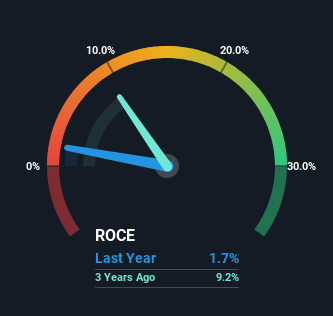- China
- /
- Auto Components
- /
- SHSE:603701
Zhejiang Dehong Automotive Electronic & Electrical (SHSE:603701) Will Be Looking To Turn Around Its Returns
When it comes to investing, there are some useful financial metrics that can warn us when a business is potentially in trouble. Businesses in decline often have two underlying trends, firstly, a declining return on capital employed (ROCE) and a declining base of capital employed. Basically the company is earning less on its investments and it is also reducing its total assets. And from a first read, things don't look too good at Zhejiang Dehong Automotive Electronic & Electrical (SHSE:603701), so let's see why.
What Is Return On Capital Employed (ROCE)?
For those that aren't sure what ROCE is, it measures the amount of pre-tax profits a company can generate from the capital employed in its business. To calculate this metric for Zhejiang Dehong Automotive Electronic & Electrical, this is the formula:
Return on Capital Employed = Earnings Before Interest and Tax (EBIT) ÷ (Total Assets - Current Liabilities)
0.017 = CN¥14m ÷ (CN¥1.0b - CN¥211m) (Based on the trailing twelve months to September 2023).
Therefore, Zhejiang Dehong Automotive Electronic & Electrical has an ROCE of 1.7%. Ultimately, that's a low return and it under-performs the Auto Components industry average of 6.6%.
See our latest analysis for Zhejiang Dehong Automotive Electronic & Electrical

While the past is not representative of the future, it can be helpful to know how a company has performed historically, which is why we have this chart above. If you're interested in investigating Zhejiang Dehong Automotive Electronic & Electrical's past further, check out this free graph covering Zhejiang Dehong Automotive Electronic & Electrical's past earnings, revenue and cash flow.
What The Trend Of ROCE Can Tell Us
We are a bit worried about the trend of returns on capital at Zhejiang Dehong Automotive Electronic & Electrical. About five years ago, returns on capital were 10.0%, however they're now substantially lower than that as we saw above. On top of that, it's worth noting that the amount of capital employed within the business has remained relatively steady. Since returns are falling and the business has the same amount of assets employed, this can suggest it's a mature business that hasn't had much growth in the last five years. So because these trends aren't typically conducive to creating a multi-bagger, we wouldn't hold our breath on Zhejiang Dehong Automotive Electronic & Electrical becoming one if things continue as they have.
The Bottom Line
In the end, the trend of lower returns on the same amount of capital isn't typically an indication that we're looking at a growth stock. Despite the concerning underlying trends, the stock has actually gained 33% over the last five years, so it might be that the investors are expecting the trends to reverse. Regardless, we don't like the trends as they are and if they persist, we think you might find better investments elsewhere.
Zhejiang Dehong Automotive Electronic & Electrical does come with some risks though, we found 3 warning signs in our investment analysis, and 1 of those is a bit unpleasant...
While Zhejiang Dehong Automotive Electronic & Electrical may not currently earn the highest returns, we've compiled a list of companies that currently earn more than 25% return on equity. Check out this free list here.
Valuation is complex, but we're here to simplify it.
Discover if Zhejiang Dehong Automotive Electronic & Electrical might be undervalued or overvalued with our detailed analysis, featuring fair value estimates, potential risks, dividends, insider trades, and its financial condition.
Access Free AnalysisHave feedback on this article? Concerned about the content? Get in touch with us directly. Alternatively, email editorial-team (at) simplywallst.com.
This article by Simply Wall St is general in nature. We provide commentary based on historical data and analyst forecasts only using an unbiased methodology and our articles are not intended to be financial advice. It does not constitute a recommendation to buy or sell any stock, and does not take account of your objectives, or your financial situation. We aim to bring you long-term focused analysis driven by fundamental data. Note that our analysis may not factor in the latest price-sensitive company announcements or qualitative material. Simply Wall St has no position in any stocks mentioned.
About SHSE:603701
Zhejiang Dehong Automotive Electronic & Electrical
Zhejiang Dehong Automotive Electronic & Electrical Co., Ltd.
Adequate balance sheet with acceptable track record.
Market Insights
Community Narratives


Recently Updated Narratives


Q3 Outlook modestly optimistic


Alphabet: The Under-appreciated Compounder Hiding in Plain Sight


MINISO's fair value is projected at 26.69 with an anticipated PE ratio shift of 20x
Popular Narratives


The company that turned a verb into a global necessity and basically runs the modern internet, digital ads, smartphones, maps, and AI.


MicroVision will explode future revenue by 380.37% with a vision towards success



